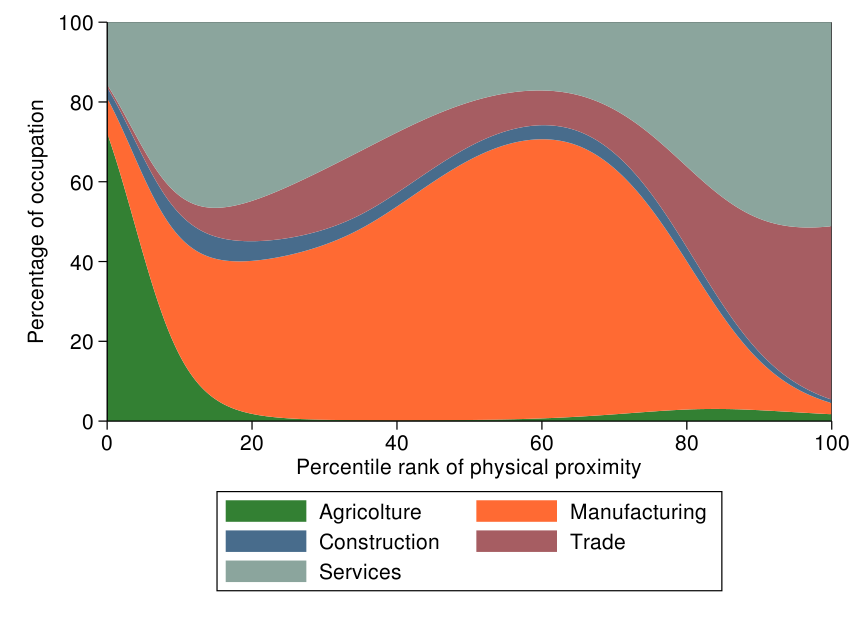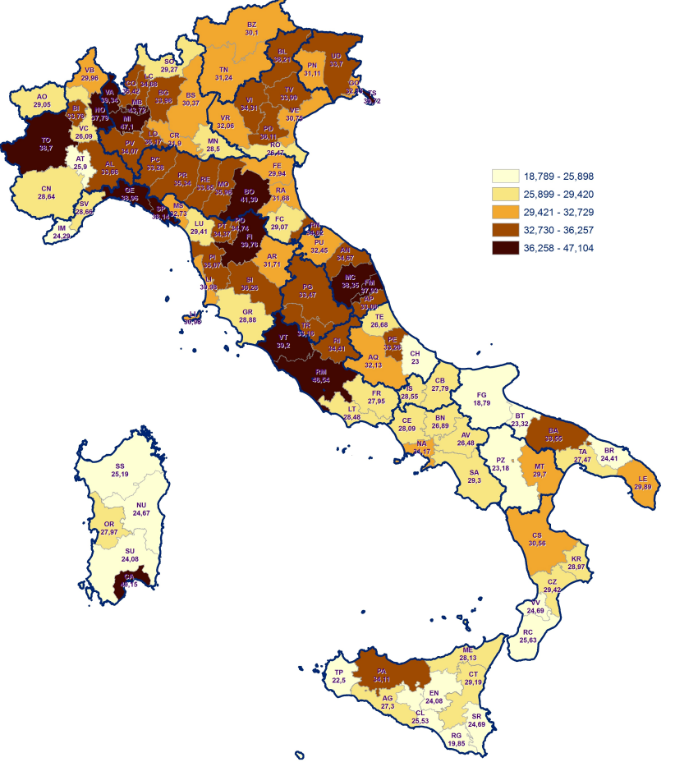Some workers are more at risk than others during an epidemic because they work in physical proximity to other people (customers, co-workers), they are exposed to diseases and infections, or both, as discussed by Gamio (2020) in The New York Times. Understanding these dimensions of risk is of utmost importance to design strategies for relaxing lockdown before a vaccine for SARS-CoV-2 is developed.
Italy was the first Western country to adopt sectoral lockdown measures to contain the spread of the new coronavirus. In a recent paper, we follow a similar approach to that of Koren and Peto (2020) and assign to each Italian occupation its degree of human proximity, disease exposure in the workplace, and feasibility for remote work, based on data from the Sample Survey on Professions (ICP), the Italian equivalent of the US Bureau of Labor Statistic’s O*Net (Barbieri et al. 2020). We then map occupations into detailed sectors of activity and, based on data predating the epidemic, we characterise the impact of the sectoral lockdowns put in place by the Italian government on 11 and 25 March 2020, with a particular focus on workers exposed to disease risks. The evidence may help policymakers select which activities to reopen first and where to reinforce security measures, complementing other suggested measures (Baldwin and Weder di Mauro 2020).
We first classify jobs and sectors of economic activity on dimensions of risk – degree of physical proximity, exposure to disease – and then according to the index of potential for remote work. The advantage of this approach is its flexibility: because a sector can be identified at levels of proximity, disease exposure, or remote work potential, based on a percentile threshold of the national occupational distribution, policymakers can choose levels that match their evaluation of risk and contagion diffusion. Other approaches identify the jobs that can be performed safely in absolute terms, thus complementing our approach.
Dingel and Neiman (2020) estimate how many jobs can be carried out from home in the US, based on the description of the working conditions of each occupation in O*Net. Building on the US O*NET classification, Boeri et al. (2020) perform a similar analysis for the European labour markets and classify jobs according to the extent to which they can be safely carried out under the epidemic, where safest jobs are considered those that can be carried out from home.
Physical proximity, disease exposure, and feasibility of remote work
The indicators of physical proximity, disease exposure, and remote work feasibility are calculated at the 4-digit occupation level for about 800 occupations, exploiting detailed information of the Italian Sample Survey on Professions. We derive the distribution of occupational employment at the 4-digit level across about 600 sectors from the 2018 Italian Labour Force Survey. These employment-based occupation weights are used to map occupations into sectors; in the spirit of Autor and Dorn’s routine employment share (Autor and Dorn 2013), we then calculate the percentage of sectoral employment in the top tercile of each index’s distribution, as well as the percentage of workers in the top tercile of the indexes. To address the arbitrariness of the threshold chosen, we also perform several robustness checks with different thresholds that could be of interest for a policymaker who is willing to tolerate a higher or lower share of workers exposed to risks.
Figure 1 shows the top 10 sectors in terms of disease exposure (Figure 1, panel A) and physical proximity (Figure 1, panel B). Unsurprisingly, the health sector stands out as the most exposed to diseases and infections, while in terms of physical proximity, the graph confirms that the service sector is the one with the highest score. However, most of these sectors are currently under lockdown, including bars, recreational and sports services, and phones, clothing, and shoe stores, as well as the education industry.
Figure 1 Top 10 sectors by diseases exposure and worker’s physical proximity
a) Top 10 sectors by disease exposure
b) Top 10 sectors by physical proximity
Source: Authors’ elaborations on the Italian Sample Survey on Professions and Labour Force Survey data.
Focusing on the employment distribution across sectors, workers high on the physical-proximity index are concentrated in the service sector (including healthcare) and in retail trade (Figure 2). Manufacturing has high variability in terms of physical proximity, while little to no physical proximity characterises agriculture, which provides necessary goods.
Looking at demographic characteristics, workers at high risk of COVID-19 infection, i.e. males over 50 years of age, are mainly concentrated in sectors that have a low degree of physical proximity (agriculture) or are currently shut down, or where, at least in principle, it is possible for a large share of workers to work from home (public administration and education).
Figure 2 Distribution of occupation by physical proximity and sector
Note: The graph shows the employment distribution for each percentile rank of the physical proximity index, by the five main industries as described in the legend.
Source: Authors’ elaborations on the Italian Sample Survey on Professions and Labour Force Survey data.
Regarding the feasibility of remote work, the activities scoring the highest are in finance, banking, insurance, public administration, and most professional services.1 Following Dingel and Neiman (2020), we depict the provincial distribution in Italy of the index of remote-work feasibility (Figure 3).2 Not surprisingly, the percentage of workers with the possibility of working remotely is higher in the country’s most populous cities (Rome, Milan, Turin, Bologna, Florence), where public administration and insurance and banking services are concentrated.
Figure 3 Provincial distribution: percentage of workers that score high in the remote working index
Note: The percentage of workers in the top tercile of each index is calculated as described in Barbieri et al. (2020), equation (1).
Source: Authors’ elaborations on the Italian Sample Survey on Professions and Labour Force Survey data.
Workers most exposed at risk and sectoral lockdowns
Using the Italian Labour Force Survey data that predate the crisis, we estimate that after the March lockdown decrees, almost 8 million workers had activity suspended, which amounts to about 35% of total employment. To understand better whether those sectors that were forced to close were also those more exposed to infection risk, we correlate the sectoral lockdowns with the indexes for physical proximity, disease exposure, and remote-work feasibility.
Results indicate that the first lockdown from 11 March targeted sectors with a significantly higher percentage (up to 52 percentage points) of workers with high physical proximity, involving workers in the restaurants and accommodation industries and part of the retail trade.
The second decree on March 25, targeted many more sectors as it aimed to reduce the outbreak by increasing the number of sectors deemed non-essential. As a consequence, there was no significant association between the new lockdown measures and the share of workers in high physical proximity. None of the lockdown measures involved sectors with a high level of exposure to diseases. This is expected as, obviously, the health industry (the most exposed to diseases and infections) provides essential services that cannot be suspended, and the education industry currently operates remotely. However, the association between the lockdown and the risk indicators hold even excluding the health and the education industries.
Finally, the share of workers who could potentially work from home is significantly higher in sectors that are still operative compared to those that were shut down (ranging from about 29 to 18% following the two March decrees). According to our estimates, the number of workers who work remotely could be up to 3 million higher than in sectors that have been shut down. Therefore, by working remotely, the risk of contagion among active workers in the service sectors has likely declined, while keeping these activities largely operational.
Authors' note: The views expressed in this column are those of the authors and do not necessarily reflect those of the Bank of Italy nor those of INAPP. This text was originally published, slightly amended, on the Bank of Italy website on 11 April 2020, on lavoce.info on 14 April 2020, and some of the findings also appeared in the INAPP Policy Brief n.16 (all in Italian).
References
Autor, D H, and D Dorn (2013), “The growth of low-skill service jobs and the polarization of the US labor market”, American Economic Review 103(5): 1553–97.
Baldwin, R, and B Weder di Mauro (2020), Mitigating the COVID economic crisis: Act fast and do whatever it takes, VoxEU.org eBook, CEPR Press.
Barbieri, T, G Basso and S Scicchitano (2020), “Italian workers at risk during the COVID-19 epidemic”, Inapp Working Paper n. 46 (also as Banca d’Italia, Occasional Papers, forthcoming).
Boeri, T, A Caiumi and M Paccagnella (2020), “Mitigating the work-security trade-off”, COVID Economics 2: 60–6, CEPR Press.
Dingel, J, and B Neiman, (2020), “How many jobs can be done at home?”, COVID Economics 1: 16–24, CEPR Press.
Gamio, L (2020), “The workers who face the greatest coronavirus risk,” The New York Times, 15 March.
Koren, Miklos, and Rita Peto (2020), “Business disruptions from social distancing”, COVID Economics 2: 13–31, CEPR Press.
Endnotes
1 The index is computed by averaging scores on: (i) the importance of performing general physical activities (reversed); (ii) importance of working with computers; (iii) the importance of maneuvering vehicles, mechanical vehicles, or equipment (reversed); (iv) the requirement of face-to-face interactions (reversed); (v) dealing with external customers or with the public (reversed); (vi) physical proximity (reversed); (vii) the amount of time spent standing (reversed).
2 In Barbieri Basso and Scicchitano (2020), we provide provincial maps for the other two indexes.










